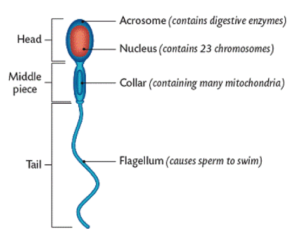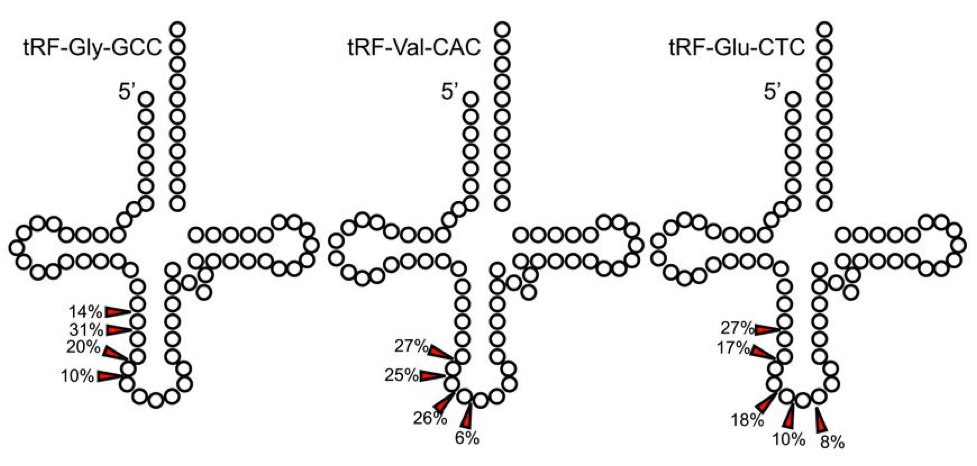- Current Genetic Dogma is DNA → RNA → Protein
- Two Research Teams Independently Implicate Sperm Short RNA Can Transmit Paternal Genetics
- More Research Needed to Elaborate the New Dogma
The Central Dogma of all life on Earth is currently understood to be DNA encoding RNA that in turn encodes protein. That genetic inheritance is transferred as DNA was first posited by uber-famous Francis Crick, who coined the term Central Dogma. While dogmatic principles, by definition, should have no exceptions, a few species of viruses can be considered to be exceptional cases in this regard.
 The Central Dogma. Taken from biology.tutorvista.com
The Central Dogma. Taken from biology.tutorvista.com
That said, there is now quite a scientific buzz—if not shudder by some—over reports implicating RNA molecules as direct (i.e. non-DNA) agents for mammalian inheritance. My instantaneous mental responses to these surprising—if not shocking—revelations was first, “Wow, who would have thunk?” and then, “I’ve got to share this news in a blog.” So here it is.
Surprising Science in Sperm
 Human sperm. Taken from leavingbio.net
Human sperm. Taken from leavingbio.net
While most of us are probably at least passingly familiar with textbook descriptions of the basic structure of sperm and its functional role in reproductive molecular biology, more detailed information on its nucleic acid content is less known. Consequently, shown below is a depiction of the basic structural components of a sperm, DNA content, and primary functions for doing its job, so to speak, in fertilization of an egg.
By way of background, here’s information that I thought was worth sharing. My Google Scholar search results for nucleic acid content of sperm included a very impressive technological accomplishment reported by uber-famous professor/entrepreneur Stephen Quake and co-workers in 2012 on microfluidic separation methods for the first ever genome-wide single-cell DNA sequencing of human sperm. Contrary to what one might intuitively expect, 91 genomes of sperm from a single individual were not identical. Since DNA from only one sperm and one egg combine during fertilization, the exact paternal DNA genotypes in the resultant offspring involves “pot luck,” so to speak.
Regarding RNA, my Google Scholar search led to a paper in 2011 by Krawetz et al. on the first ever report of deep-sequencing of short (18-30 bases) RNA (sRNA) in human sperm (for which TriLink offers a high-performance CleanTag™ kit for sRNA library prep as detailed on this poster). Krawetz et al. found microRNA (miRNA) (≈7%), piwi-interacting RNA (piRNA) (≈17%), and repeat-associated sRNA (≈65%). A minor subset of sRNA within the transcription start site/promoter fraction (≈11%) frames the histone promoter-associated regions enriched in genes of early embryonic development. However, reproductive roles for this molecular menagerie (what I tongue-in-cheek call these various sRNAs) remain speculative.
Fast forwarding to present time leads us to the two “wow” publications in venerable Science that triggered this blog:
- Biogenesis and function of tRNA fragments during sperm maturation and fertilization in mammals by Upasna Sharma et al. in the USA and Canada; and
- Sperm tRNAs contribute to intergenerational inheritance of an acquired metabolic disorder by Qi Chen et al. in China and the USA.
While you’ll need to read these publications for details, they collectively raise the following controversial question vis-à-vis the Central Dogma for strictly DNA-based inheritance.
Are You Inheriting More Than Genes from Your Father?
Yes, is the surprising—if not bombshell—answer to this question, which I borrowed from Mitch Leslie’s Science editorial headline. If this conclusion is supported by further studies, it forces a fundamental revision of reproductive molecular cell biology. That’s a very big deal, so to speak, with ramifications not to be under appreciated.
Using sRNA library preparation methods analogous to TriLink CleanTag™ for Illumina deep-sequencing, the USA-Canadian team analyzed sperm from male mice fed a low-protein diet, progeny of which showed elevated activity of genes involved in cholesterol and lipid metabolism. They found that >80% of sRNA were fragments from several kinds of transfer RNAs (tRNAs). Most notably, 5′ fragments of tRNA-Gly-CCC, -TCC, and -GCC shown below all exhibited an approximately 2- to 3-fold increase in low-protein sperm.
 Arrows indicate ~30- to 34-nt 5′ tRFs. Taken Upasna Sharma et al. Science (2016)
Arrows indicate ~30- to 34-nt 5′ tRFs. Taken Upasna Sharma et al. Science (2016)
To understand when, where, and how these tRNA fragments were formed, as well as unravel functional significance, the researchers describe an experimental tour de force—in my opinion. This included antisense modified-oligonucleotide “knock-out” of these tRNA fragments, as well as “knock-in” injection of <40-nt sRNA populations purified from control and low-protein sperm into control zygotes.
The researchers concluded that the sperm acquired most of these fragments while passing through the epididymis, a duct from the testicle where the cells mature. Functionally, they also link tRNA fragments to regulation of endogenous retro-elements active in the preimplantation embryo.
In the second study, the China-USA team also found tRNA fragments by deep-sequencing of sRNA. After feeding male mice either a high-fat or low-fat diet, the scientists injected the animals’ sperm into unfertilized eggs, and then measured metabolic performance of the offspring, which ate a normal diet. Progeny of fat-eating fathers remained lean; however, they showed two abnormalities often found in their dads and in humans who are obese or diabetic—abnormal absorption of glucose and insensitivity to insulin.
Like the first study, these researchers also did “knock-in” experiments wherein they inserted the tRNA fragments into eggs fertilized with other sperm. Fragments that came from fathers that ate the high-fat diet resulted in offspring that also showed impaired glucose absorption.
Take Home Messages
At the risk of over simplifying or over generalizing, the aforementioned two studies of sRNA in sperm provide compelling—and stunning—evidence for how tRNA fragments in sperm are responsible for inheritance independent of sperm DNA sequences. So much for dogma.
With regard to specifics, researchers now need to investigate how permanent these changes are, and how quickly they can be reversed by changing diet.
The flip-side of a bad diet adversely influencing offspring is to investigate if and how a good diet imparts better health to offspring.
Please share your thoughts about these reports, conclusion, and implications by commenting here.
Postscript
If you enjoy hip hop music—or just want to chuckle—this YouTube video for the Central Dogma song will get your head bobbing in sync with the music, lead you to smile, and give you a cool visual display of the central dogma.






